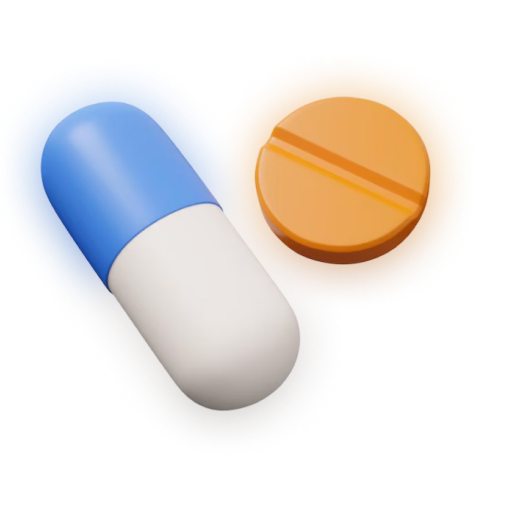Paracetamol comp. 500 mg/30 mg 100 caps
Analgesic / Pain Relief Medication


Description
Generic Name: Paracetamol + Codeine Phosphate
Brand Name: Various generics (commonly “Paracetamol comp.”)
Drug Class: Paracetamol: Non-opioid analgesic and antipyretic
This is a prescription medicine, which requires a valid prescription!
Indications
- Moderate Pain Relief:
- Used for short-term treatment of moderate to moderately severe pain when paracetamol alone is not sufficient.
- Common indications include postoperative pain, dental pain, headache, musculoskeletal pain, and dysmenorrhea.
- Used for short-term treatment of moderate to moderately severe pain when paracetamol alone is not sufficient.
- Fever (limited use):
- May be used for fever associated with painful conditions, but not first-line due to opioid content.

- Paracetamol (500 mg):
- Inhibits prostaglandin synthesis in the central nervous system, leading to analgesic and antipyretic effects.
- Inhibits prostaglandin synthesis in the central nervous system, leading to analgesic and antipyretic effects.
- Codeine Phosphate (30 mg):
- A prodrug converted into morphine in the liver via CYP2D6.
- Binds to opioid receptors in the brain and spinal cord, altering the perception of and response to pain.
- A prodrug converted into morphine in the liver via CYP2D6.
- Form: Oral capsules, each containing 500 mg Paracetamol + 30 mg Codeine
- Adults and adolescents ≥12 years:
- Dose: 1–2 capsules every 4–6 hours as needed
- Maximum: Do not exceed 8 capsules in 24 hours (equivalent to 4 g paracetamol / 240 mg codeine)
- Dose: 1–2 capsules every 4–6 hours as needed
- Duration:
- Use at lowest effective dose for the shortest duration, generally not exceeding 3 days without medical advice.
- Children <12 years:
- Contraindicated due to risk of serious breathing problems (see below).
- Contraindicated due to risk of serious breathing problems (see below).
- Common:
- Nausea, constipation
- Drowsiness, dizziness
- Dry mouth
- Mild euphoria or sedation
- Serious (rare):
- Respiratory depression (especially in ultra-rapid CYP2D6 metabolizers)
- Hepatotoxicity from paracetamol overdose
- Opioid dependence and withdrawal symptoms
- Allergic reactions (rash, swelling, anaphylaxis)
- Pancreatitis (rare)
- Known hypersensitivity to minoxidil
- Severe heart disease (e.g., ischemic heart disease, heart failure)
- Pheochromocytoma (risk of worsening hypertension)
Information
Warnings and Precautions:
- Children under 12 years: Contraindicated due to unpredictable codeine metabolism and risk of respiratory depression.
- CYP2D6 Ultra-rapid Metabolizers: Risk of morphine overdose; avoid use.
- Liver Disease / Alcohol Use: Increased risk of hepatotoxicity; use with caution.
- Breastfeeding: Contraindicated – codeine may pass into breast milk and cause life-threatening effects in the infant.
- Driving and Operating Machinery: May cause drowsiness and impair ability to drive or use machines.
- Addiction risk: Use only for short-term relief; monitor for signs of misuse or dependency.
Overdose Risk:
- Paracetamol overdose can cause fatal liver failure. Immediate medical attention is essential even if no symptoms are present.
Drug Interactions:
- Alcohol: Increases risk of liver toxicity and sedation.
- Other CNS depressants (e.g., benzodiazepines, antihistamines): Additive sedative and respiratory depressant effects.
- Enzyme inducers (e.g., rifampin, phenytoin): May reduce paracetamol efficacy and increase toxicity risk.
- MAO Inhibitors (past 14 days): Avoid use with opioids—risk of serotonin syndrome or CNS toxicity.
- Warfarin: Chronic paracetamol use may enhance anticoagulant effect; monitor INR.
Request Now
Direct Enquiries
For any inquiries, please feel free to contact us directly via email at the link below.
pharmacy@doctorworld.eu
PLEASE AVOID SELF-DIAGNOSIS AND SELF-MEDICATION!
Our website content is posted for informational purposes only. It is not intended to be used for primary diagnoses-making and should not replace a consultation with a professional health care provider. If you have any health issues or complaints, please consult your primary physician.
Health care data provided for informational purposes is not an alternative to an in-person physician consultation.